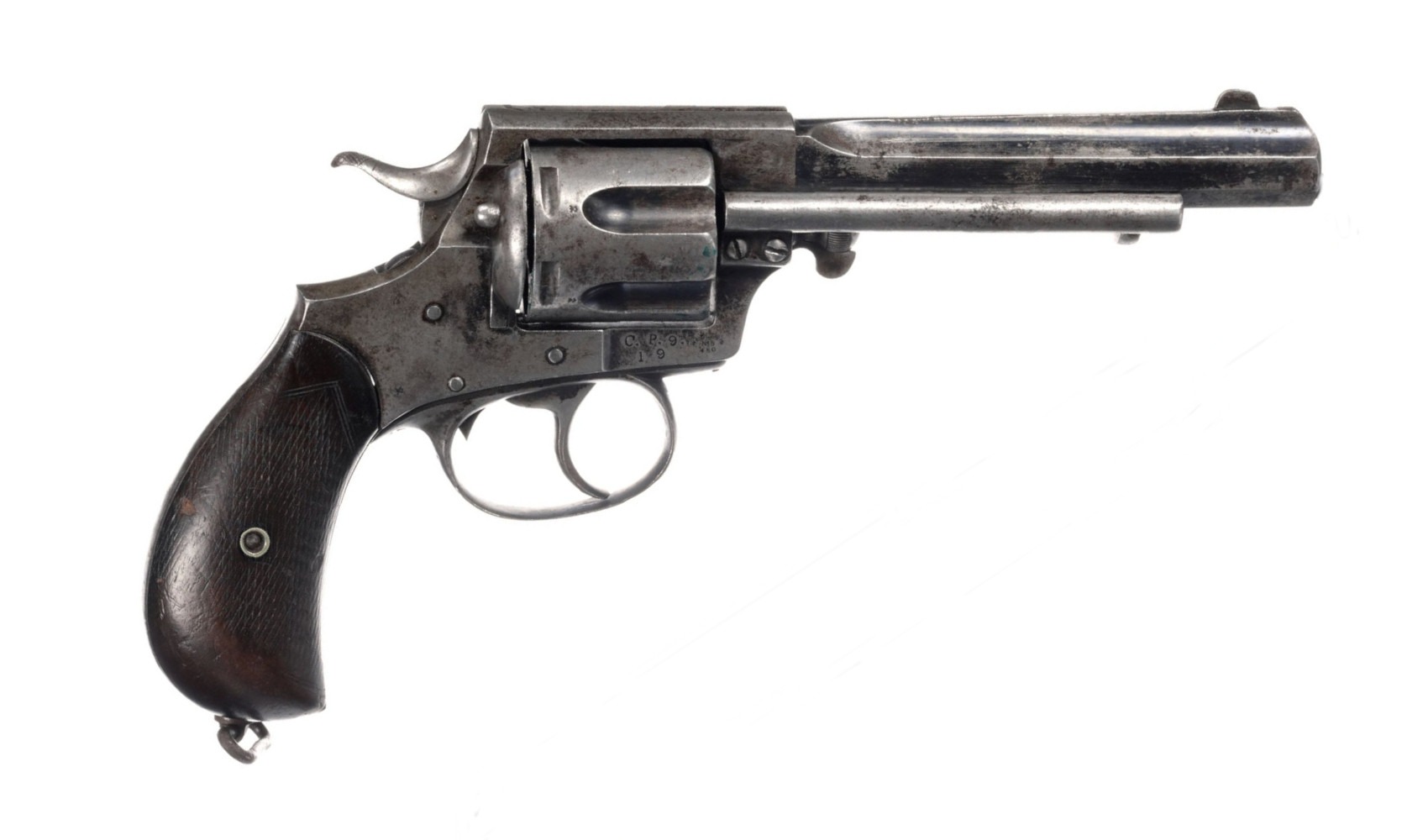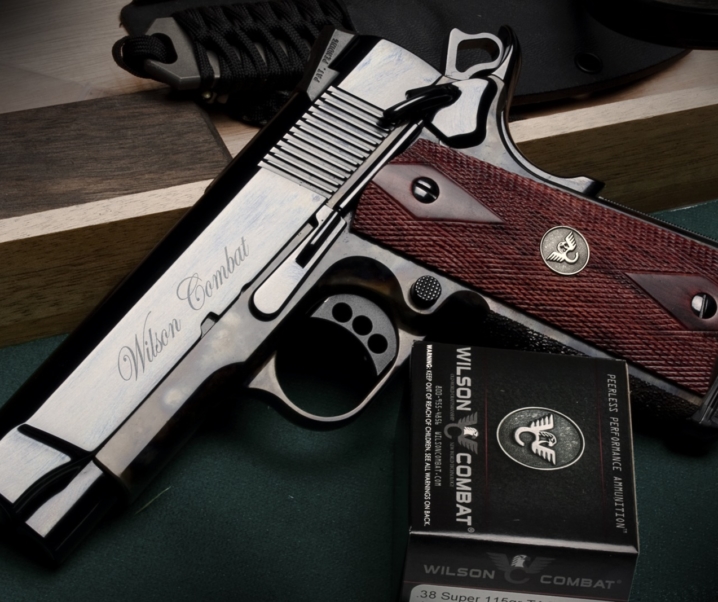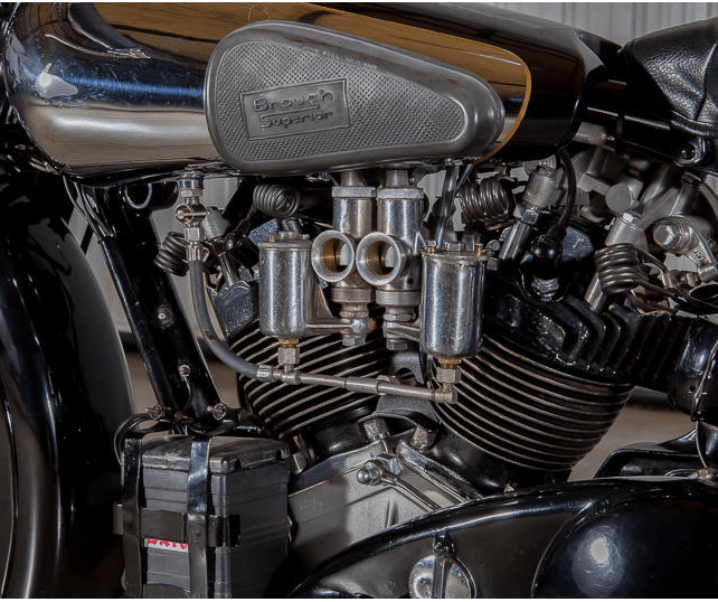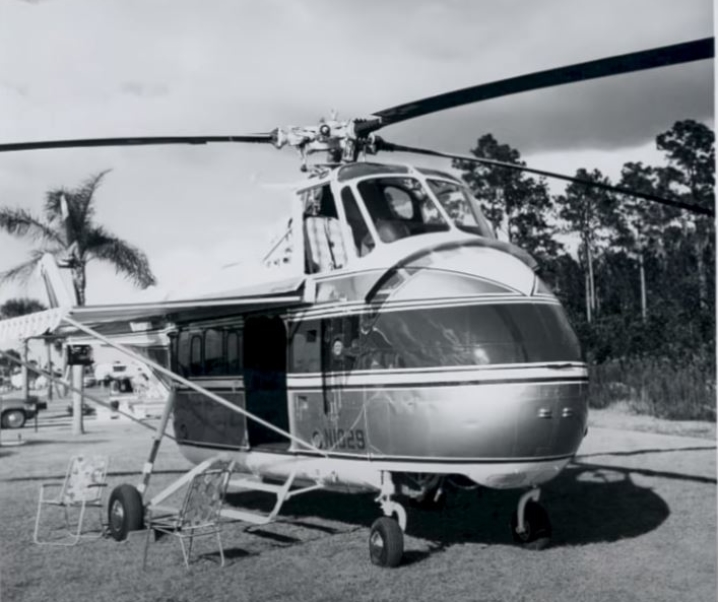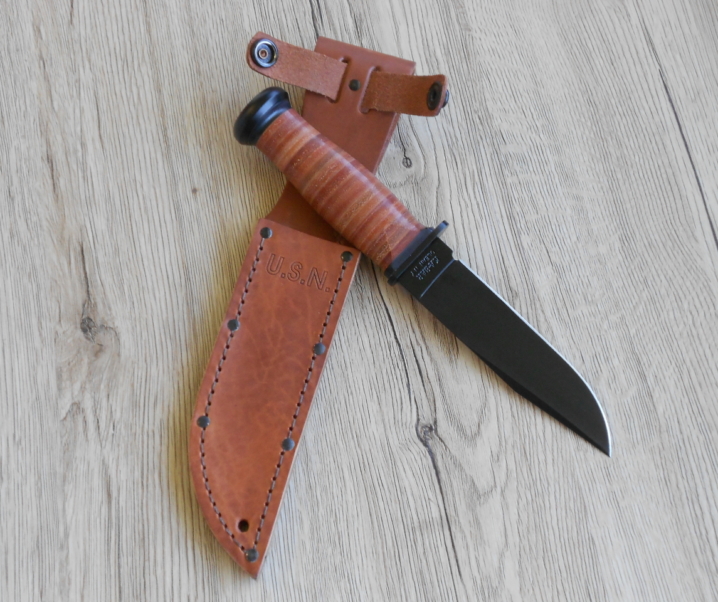In the United States the Colt 1873 Single Action Army became the best known revolver of the 1870’s through to the end of the nineteenth century, with the Smith & Wesson No. 3 in second place, and in the British Empire the Colt SAA was well regarded in the 1870’s – 1880’s and its .45 Colt cartridge was favoured by many.
Britain’s empire – which stretched across the entire world – presented both an enormous market for small arms such as revolvers: and it also extended into areas of diverse climate, landscape, and culture.
In fact when I was a schoolboy in England back in the 1950’s the world maps in the atlases at school coloured the countries of the empire in a reddish pink colour – and that reddish pink seemed to cover most of the world.
So while the United States is famous for its Wild West, the British Empire also had a wild west over in Canada, and it also had a wild east that extended from India, to Malaya and China. It had a wild Middle-East, and a wild south in Africa, Australia and New Zealand.
At that time the British gun trade was extensive, primarily located in London and Birmingham, and the inventiveness that came out of those gunmakers was second to none in the world.
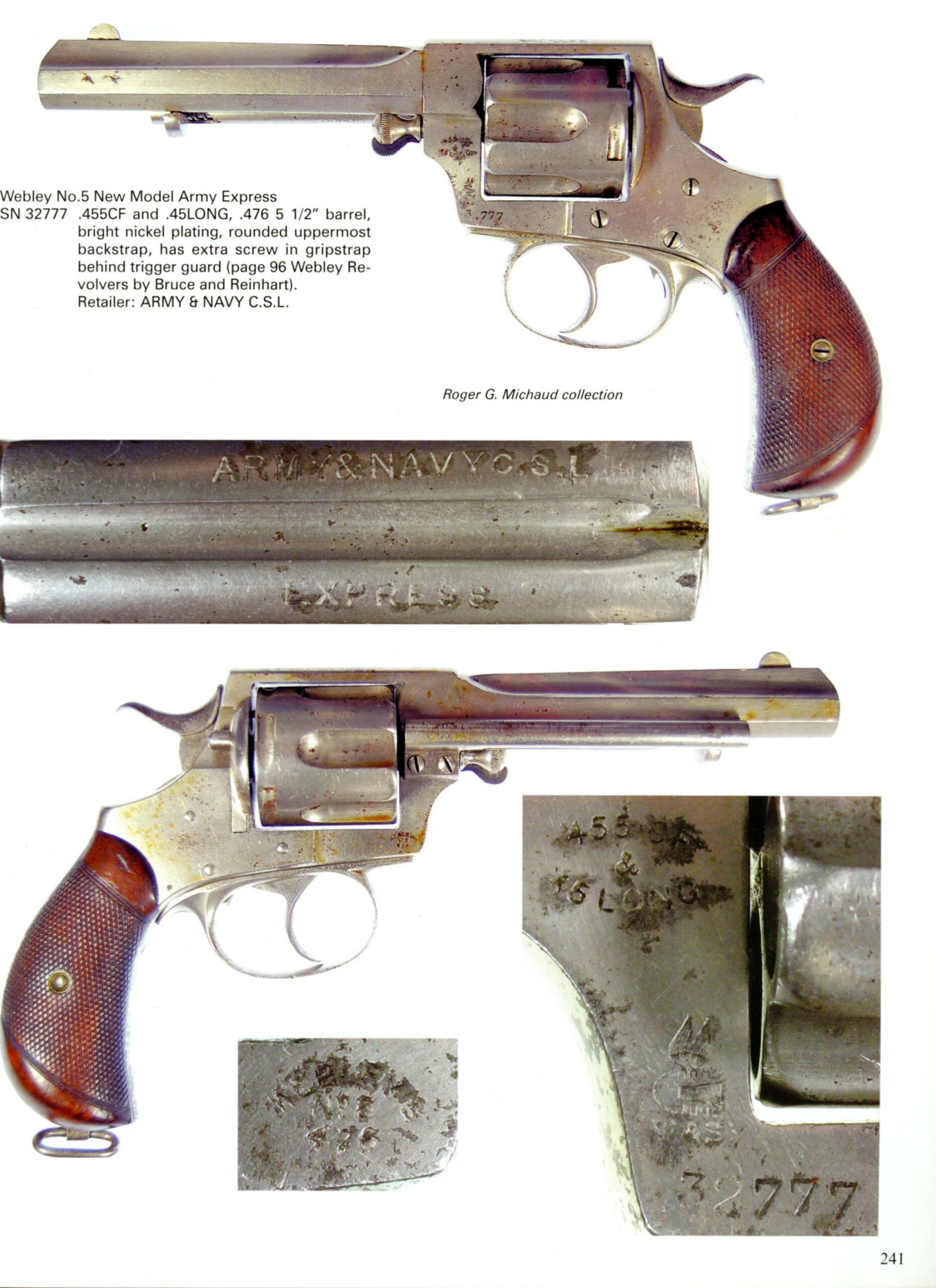
Fast Facts
- The Webley No.5 New Model revolver was made as a solid-frame, fixed-cylinder, gate-loading revolver despite the fact that Webley’s Webley-Pryse No.4 revolver was a break-action that was much faster to load and reload.
- The No.5 was designed to provide a revolver that offered all the advantages of the Colt Single Action Army, but with double-action.
- The No.5 was made to be able to use the 455 Webley cartridge – which had become the British military standard, and also the obsolete 450 and 476. But not only that, it was specifically made to use the 45 Colt cartridge to take advantage of its superior power.
- In addition to these cartridges the No.5 was made chambered for the 44-40 rifle cartridge, so it could act as the companion revolver for a person with a 44-40 rifle.
- The No.5 was offered in 44 Russian, and 44 Colt.
- A version of the No.5 was made chambered for the 360 Rook cartridge and this was popular for target shooting as well as for civilian and police use.
- A Webley No.5 New Model Army Express is coming up for sale by Rock Island Auction on June 22, 2023.
What the empire’s revolver users needed was a weapon that was made simple to keep it as reliable as humanly possible, it needed to be in .45 calibre to deliver the decisive stopping power required to stop physically strong and determined assailants, and it needed to be flexible in the ammunition it would efficiently use.
Although the standard British military cartridge by then was the 455 Webley, a British military revolver of that transitional era also needed to be able to use the older 450 and 476. It was also preferred that it be able to use the powerful 45 Colt (i.e. the “Long Colt”) as many favoured that cartridge above the shorter 455 Webley and with good reason.
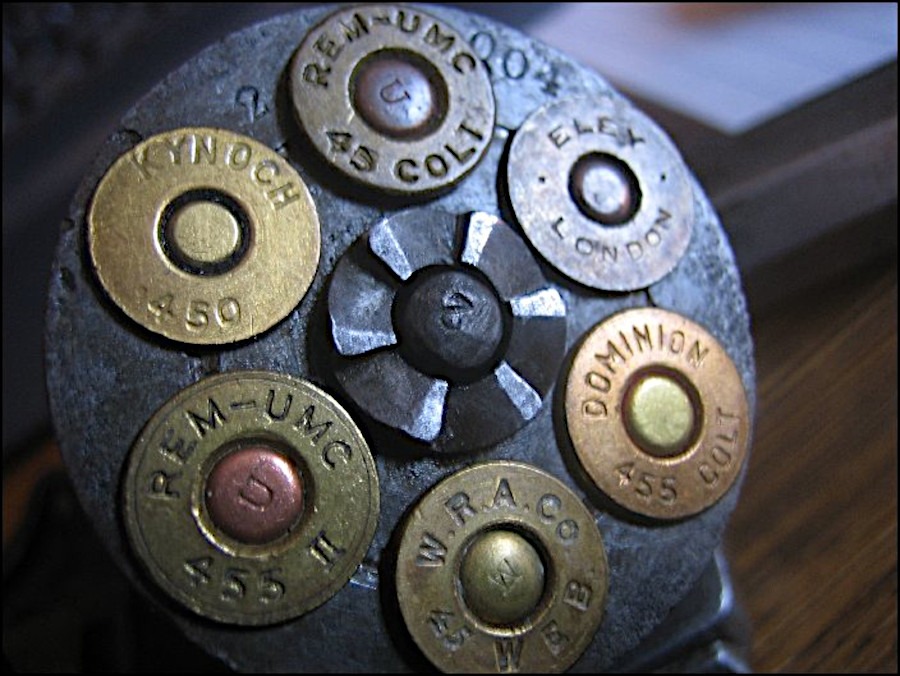
The idea of creating a revolver that would provide the rugged simplicity and stopping power of the Colt Single Action Army, but which offered both single and double action, looked to be a sensible weapon to manufacture and sell despite the fact that Webley’s vision was really to make double-action revolvers with a break action that would allow fast and easy ejection of all the spent cartridge cases in one simple action, and to reload swiftly ready for more action.
The downside of a break-action revolver is of course the notion that it is not as strong as a solid-frame revolver. So in the United States the Colt Single Action Army was more popular than the break-action Smith & Wesson No. 3 (and Schofield model) for example. The Single Action Army was simple, reliable, and chambered for the more powerful cartridge – but was also capable of using the shorter 45 Smith & Wesson cartridge also.
Webley’s earlier revolvers, such as the R.I.C. (Royal Irish Constabulary) and Bulldog had begun life in the 1860’s and were solid-frame gate loading arms. So for Webley the idea of returning to that action type might have seemed to be a step backwards.
So despite Webley having put their Webley-Pryse No.4 revolver into production, Webley’s No. 5 revolver was to be like its R.I.C. and Bulldog siblings, a solid-frame, fixed cylinder, gate loading arm.
In the process of designing their new No. 5 revolver Webley faced the literal minefield of patents surrounding firearms design, much of which were for lockwork used in revolvers. So part of the design rationale for the Webley design team was to avoid infringing on anybody else’s patents. The gentlemen at Webley seem to have taken an entirely pragmatic approach to this problem by making the revolver as boringly simple as possible.
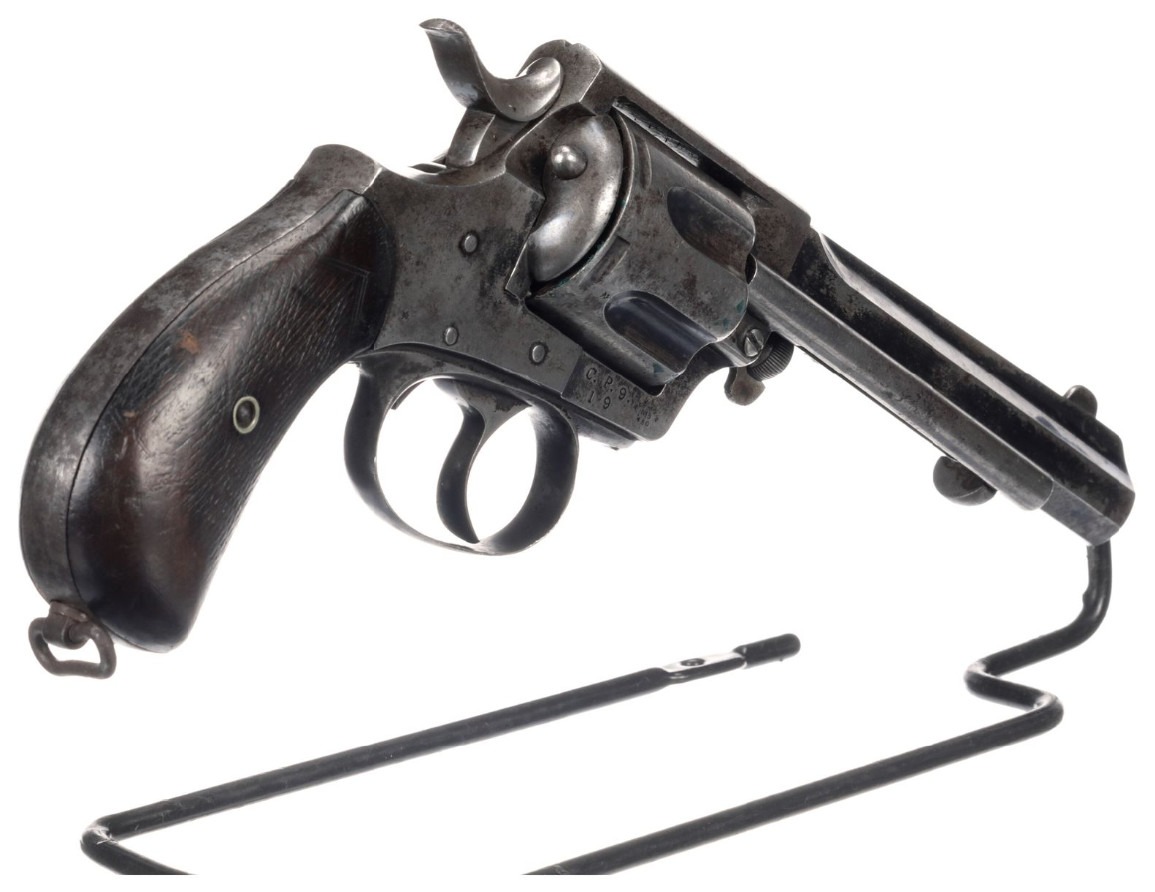
The new No. 5 was not to have a rebounding hammer system, so, just like the Colt S.A.A., when the hammer fell it stayed fallen on the fired cartridge – or on an empty chamber.
The hammer needed to be brought to half-cock before opening the loading gate. Once this was done the cylinder was free to rotate and fired cartridges could be ejected using the ejector rod mounted onto the barrel – this rod being spring loaded like that of the Colt S.A.A.
Loading was done one cartridge at a time, the cylinder having to be manually rotated to the correct position to line up with the fresh round.
With no rebounding hammer the No.5, like the Colt S.A.A., needed to be carried as a five shooter not a six: the revolver was only safe to carry with an empty chamber under the hammer.
An interesting design feature showing Webley’s attention to detail was that the revolver cylinder spindle was fitted into a removable sleeve, and then into the cylinder itself. This was done to make the rotation of the cylinder as trouble free as possible by providing two surfaces around which the cylinder could rotate thus spreading the load and the fouling.
The No. 5 was designed for black-powder, and for corrosive mercury-fulminate primers. So if the revolver was being busily fired and there was a long period of action required before it could be cleaned then the sheer simplicity of the mechanism, and provision of such features as the sleeved cylinder spindle, provided the revolver user with as good a fail-safe as was possible.
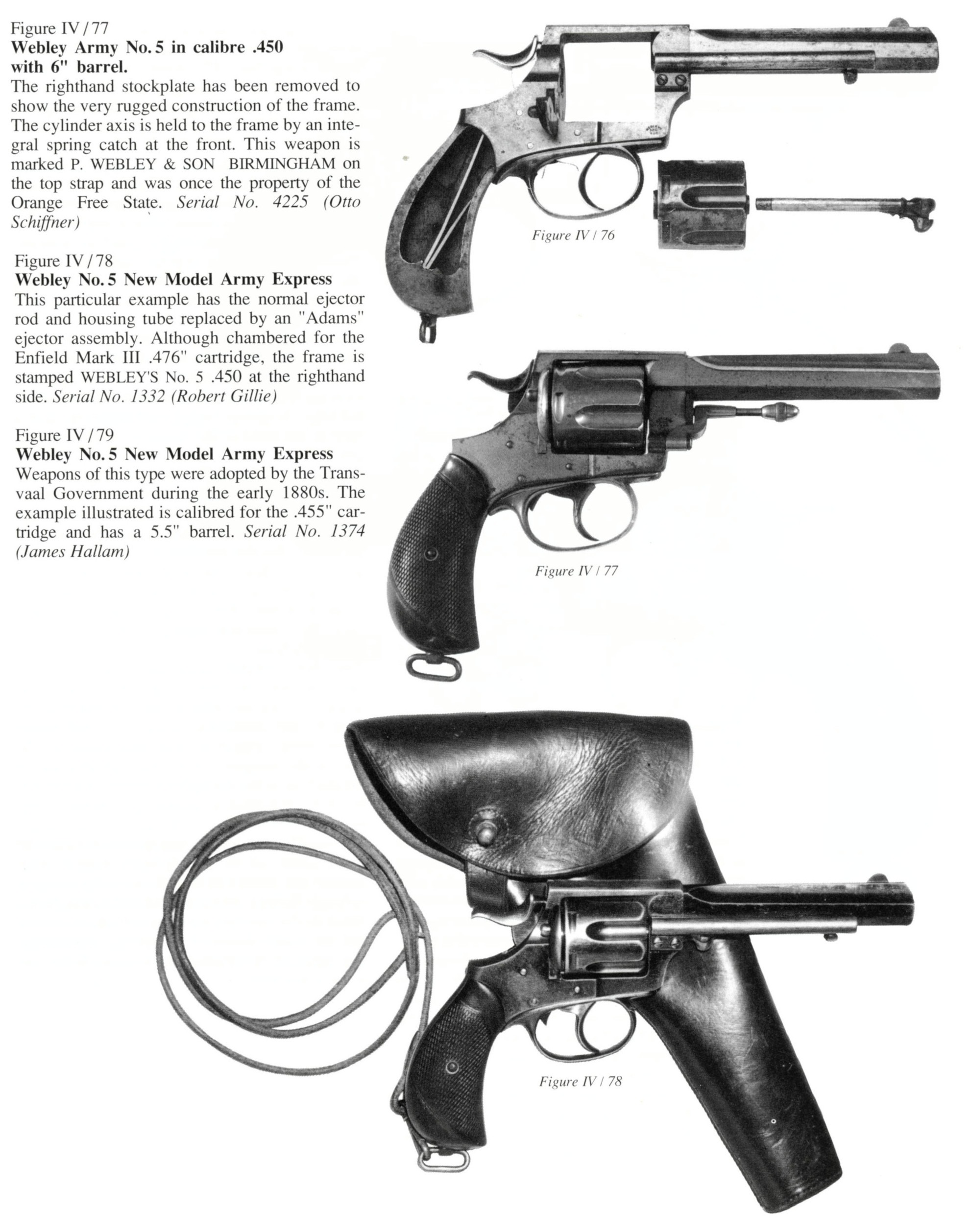
And if the revolver ran out of ammunition before the emergency could be settled then recourse to prayer and sabre were the best choices – and in that order, with the revolver perhaps needing to be used as a bit of a club in an attempt to dissuade one’s assailants from behaving quite so rudely.
The Webley No.5 was indeed designed to be so rugged that it was tough enough to deliver whatever dissuasion was needed in order to repel the attack, without suffering harm to itself.
The Webley No.5 was made in two main variants: the original No.5 which is quite rare, and the “New Model” which is most commonly referred to as the “New Model Army” or “Army Express”, or with those put together as the “No.5 New Model Army Express”.
The use of the word “Express” seems to some to be a bit out of context but it always was a marketing word used in much the same way as the word “Magnum” which is so commonly used today.
In this black-powder era the term “Express” was derived from the term “Express Train” which conjured up the idea that a cartridge would hit its quarry with the force of a fast moving express train.
The black-powder “Express” cartridges were sporting rifle cartridges such as the 450-400 Express up to the 577 Express. This later family of black-powder express cartridges later gave way to the new Nitro Express cartridges of the smokeless powder era, made possible by Alfred Nobel.
So the use of the word “Express” for the Webley No.5 New Model Army revolver was simply marketing to associate the revolver with the powerful “Express” rifle cartridges that had gained much respect, especially in Africa and Asia.
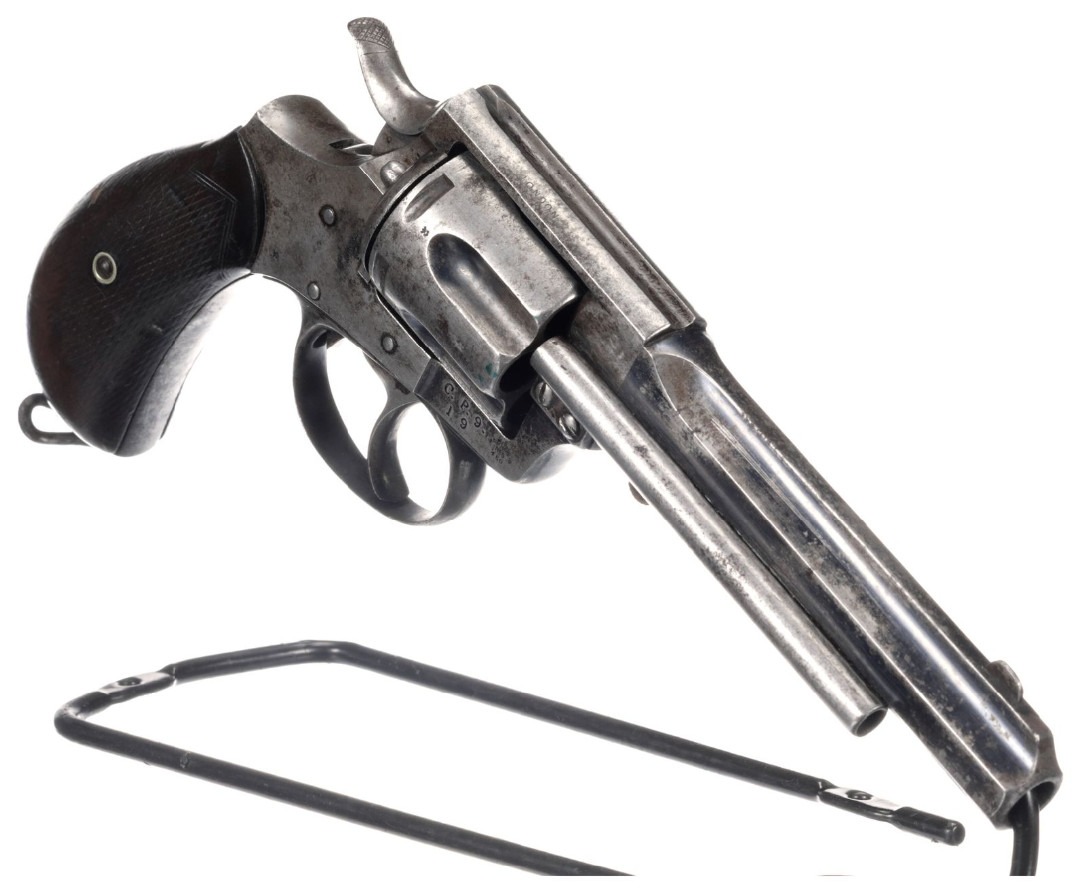
As the Webley No.5 New Model Army Express could happily use the 45 Colt (i.e. “Long Colt”) as well as the various 45 cartridges of the British Empire I think it might have actually earned itself the name “Express”.
The No.5 New Model Express was also offered chambered for the American 44-40 WCF rifle cartridge just as the Colt S.A.A. was, and additionally examples will also be found chambered for the 44 Smith & Wesson Russian and 44 Colt.
With its rugged dependability, good ergonomics, and rather catholic taste in 45 calibre ammunition, the Webley No.5 New Model Army Express earned itself a sound reputation and these revolvers were popular in southern Africa, and to a lesser extent in Australia. Additionally they saw service all across Britain’s empire.
That being said these revolvers seem to have a fairly low survival rate – most likely from having been too tough for their own good, which resulted in most of them being used to destruction over a century or so of hard use. Normal military, police, and civilian use would have seen them fed a diet of corrosive primers, corrosive black powder, dust, mud, and whatever else might have come their way.
So I think that the Webley No.5 New Model Army Express can rightly be considered as the British equivalent of the Colt Single Action Army, and they were no doubt used by some equally larger than life characters as the Colt. There was even a single-action version of this revolver made for cavalry use, and that model is very rare. It has a smaller trigger-guard for its single-action trigger but is otherwise the same as the double-action No.5 New Model.
Related to the No.5 Army Express there was also a very similar version made to take the .360 Rook cartridge. This model being intended for civilian and police use. Some of these are marked as being suitable for .38 calibre ammunition.
These can sometimes turn up with extra long barrels for target shooting, and there was also a model made with a detachable shoulder stock.

The Webley No.5 New Model Army Express for Sale by Rock Island Auction.
There are a number of Webley and other antique British revolvers coming up for sale by Rock Island Auction on June 22nd, 2023.
There is an ex Cape Police No.5 New Model Army Express among them and you will find its sale page here.
The condition of this ex Cape Police No.5 is described by Rock Island Auction as follows:-
“Rating:
OD – VERY GOOD- all original parts; none to 30% original finish; original metal surfaces smooth with all edges sharp; clear lettering, numerals and design on metal; wood slightly scratched or bruised.
WW – WOOD IS WORSE FOR THE PERCENT FINISH RATING GIVEN
Description:
Cape Police marked “C.P.9./19” on the right of the frame. “V&R BLAKEMORE/LONDON” marked on top of the frame. Lanyard ring on the butt. Includes a British Army & Navy brown leather flap holster with the name “MORISON” handwritten in black ink on the outside.”
You can also find the other interesting revolvers, including a No.4 Webley-Pryse, if you click here.
Conclusion
The Webley No.5 New Model Army Express stands out as one of great revolvers to come out of the gunmakers of the British Empire during the 1870’s. It successfully combined the best features of the American Colt Single Action Army with British double-action, and the ruggedly strong construction which tended to be a feature of Webley arms.
The No.5 was made in an extensive range of variants demonstrating the imaginative analytical design thinking of the team at Webley at that time of its history: and its quality control was beyond reproach.
If you are a Webley collector then the No.5 represents a major strand of the company’s revolvers, a strand that was ultimately to be brought to an end as the company moved over to break action revolvers as they changed their model nomenclature from Numbers (No.) to Marks (Mark I, Mark II etc).
I think that the Webley No.5 happens to be one of the more underrated of the Webley revolvers, overshadowed by its more complex break action siblings, but it happens to be a personal favorite for me because of its rugged simplicity, understated aesthetics, and its ability to use the powerful 45 Colt or 44-40 cartridges depending on chambering.
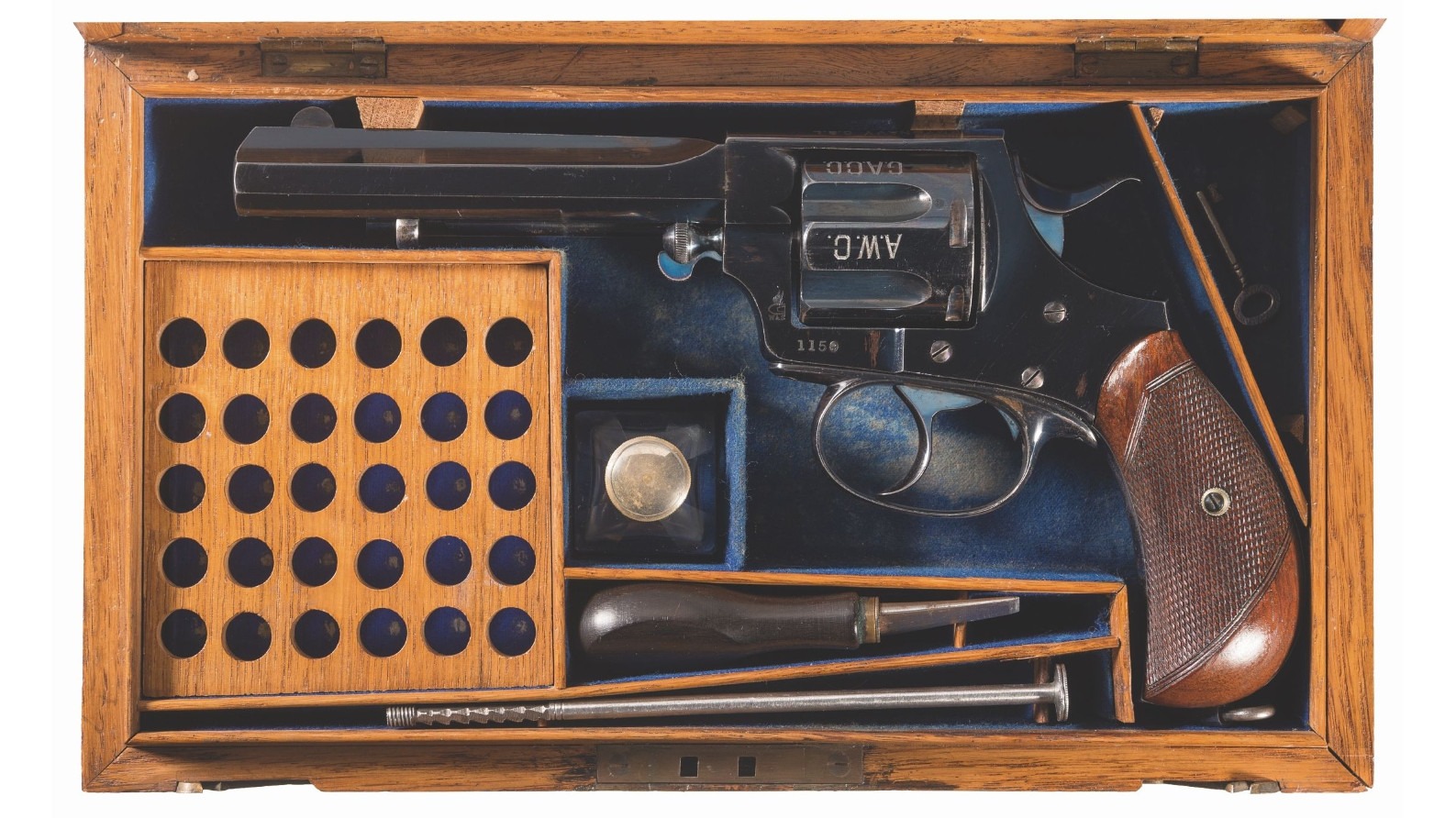
Documented, Cased Army & Navy C.S.L. Webley No. 5 Express Double Action Revolver that was sold by Rock Island Auction in 2019.
The sale page of the above revolver is archived at Rock Island Auction.
Books
- “Webley Revolvers” by Bruce and Reinhart.
- “Webley Solid Frame Revolvers Models RIC, MP, and No. 5” by Joseph L. Davis, Roger G. Michaud , Joel Black
- “Webley Solid Frame Revolvers: Nos. 1, 1 1/2, 2, Bull Dogs, and Pugs” by Joel Black, Homer Ficken, Frank Michaels

Jon Branch is the founder and senior editor of Revivaler and has written a significant number of articles for various publications including official Buying Guides for eBay, classic car articles for Hagerty, magazine articles for both the Australian Shooters Journal and the Australian Shooter, and he’s a long time contributor to Silodrome.
Jon has done radio, television, magazine and newspaper interviews on various issues, and has traveled extensively, having lived in Britain, Australia, China and Hong Kong. His travels have taken him to Indonesia, Israel, Italy, Japan and a number of other countries. He has studied the Japanese sword arts and has a long history of involvement in the shooting sports, which has included authoring submissions to government on various firearms related issues and assisting in the design and establishment of shooting ranges.

